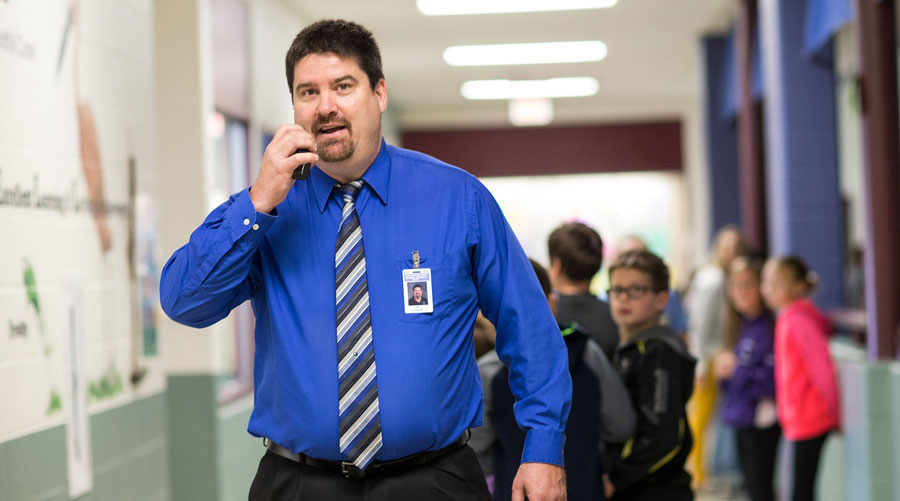In an era where school safety concerns are more urgent than ever, having strong emergency procedures in place is a core part of preparedness. Administrators and school security officials know that managing safety requires a comprehensive plan that addresses a variety of emergency situations, including extreme weather events, medical risks, bomb threats and active assailants.
For K-12 schools, lockdowns are an essential part of a school safety plan and can be an effective strategy for managing security during a crisis. The Washington Post reports that during the 2017-2018 school year, over 4.1 million students experienced at least one school lockdown. CNN reports that over 95 percent of public schools in the U.S. had conducted lockdown drills before the COVID-19 pandemic.
While experts consider lockdowns to be the best response to some school crisis situations, there are downsides to this approach. The National Association of School Psychologists reports that lockdowns can produce anxiety, stress and symptoms of trauma in students and staff.
Despite the potential drawbacks, lockdowns are a crucial part of crisis management strategies for schools. However, it’s imperative that administrators clearly understand when and how to implement a lockdown. Additionally, school safety managers must be able to quickly initiate lockdown procedures and communicate key details and instructions to faculty members, students and parents.
There are many factors to consider when running a lockdown procedure, whether it is a drill or not. It’s essential that drills optimize safety without exacerbating the negative psychological impact on students. With proper planning, administrators can help prepare the community to respond to a crisis without inflicting unnecessary fear on young children, faculty and parents. In order to understand what is appropriate and necessary in safety drills, administrators should familiarize themselves with the different types of lockdown situations and procedures.
It’s vital for schools to have more than one emergency protocol; different situations and environments require unique responses. For example, the emergency response drill for a weather event should be different than for a medical issue or active shooter. If the school is only prepared for an assailant, administrators may be unable to respond appropriately to emergency situations deemed lower-risk. This can potentially escalate a situation that could have been managed by simply locking a door and clearly communicating details and instructions to affected parties.
Soft vs. hard lockdowns
There are key differences between a hard lockdown (which impacts internal operations) and a soft lockdown (which involves the town, county or community as a whole):
- Hard lockdown: Used in the event of an immediate threat on campus and requires the school to go into an internal emergency procedure.
- Soft lockdown: Used to respond to a possible threat in the surrounding area (e.g., law enforcement activity in the neighborhood) and generally allows classroom instruction to continue.
During a hard lockdown, students and faculty members are prohibited from moving around within the school. They are required to remain within a locked classroom. In some districts, students and teachers are advised to move away from the doors and windows and/or to seek shelter. If a school is in a region impacted by severe weather (e.g., hurricanes, earthquakes or tornadoes), the campus may have a separate protocol for responding to these situations.
In a soft lockdown, teachers and students may move around within the school. Classes typically continue as usual, though class periods or schedules may change, depending on the situation. However, no one is allowed to leave the school during a soft lockdown, and some schools may prohibit movement between buildings, which could potentially affect some classes. For example, a coach would likely not be able to hold physical education classes outdoors.
During a soft lockdown, individuals may be prohibited from entering the school. Even parents and registered guardians may be required to request permission to enter, and administrators maintain the right to deny entry in order to ensure school safety. In some instances, the school may heighten security at a time when doors are typically open, such as the morning drop-off period.
How to conduct a soft lockdown
School administrators must create clear, comprehensive lockdown procedures ahead of time so they can be implemented quickly and correctly during a crisis. Emergency preparedness documents and crisis management strategies should include assessment questions for determining when to initiate a hard or soft lockdown along with steps for doing so.
The exact steps of a school’s soft lockdown procedure will depend on the facilities, infrastructure and crisis scenario. However, the following steps are generally included:
- Assess the situation and decide to initiate a soft lockdown.
- Inform students, staff, local officials, law enforcement and parents/guardians of soft lockdown status via multiple channels (e.g., PA system, smartphone notifications, SMS text messages and emails).
- Have designated individuals (e.g., school safety officers and administrators) report to the predetermined muster location for incident management.
- Secure external entry points.
- Follow established procedures for continuing (or stopping) classroom instruction.
If a school’s soft lockdown procedure incorporates restrictions on entering the campus, it’s crucial for administrators to communicate the rules beforehand to prevent panic and confusion. It’s imperative for students, staff members, 9-1-1, law enforcement, parents, government officials and even local media to have comprehensive, current information on lockdown procedures.
When to initiate a soft lockdown
School administrators may initiate a soft lockdown whenever they feel it is necessary to protect students, teachers and other staff members. For example, if a crime or dangerous incident happens in the city, town or local area near the school, security officials will often communicate with law enforcement to determine whether the school should be put on soft lockdown.
If there is a suspect in the area or an arrest is being made nearby, district officials may decide to institute a soft lockdown until law enforcement indicates that the situation has concluded. For this protocol to work effectively, there must be clear communication between 9-1-1, local safety managers and administrators.
Leveraging cutting-edge communications technology to facilitate school lockdowns
During a lockdown, it is vital for administrators, teachers and staff to communicate. There must also be clear communication with students, parents and law enforcement (when necessary). Rave Alert mass communications software facilitates fast, reliable emergency notifications to targeted groups as well as two-way communication that simplifies status checks and improves situational awareness.
During these procedures, there are a lot of considerations for safety managers to make. For example, they must make sure teachers (including substitutes and temporary instructors) know how to properly lockdown the classroom. Administrators may also need to notify staff members, such as the school nurse, of a medical emergency or mental health crisis.
A panic button app can also be a valuable tool for assisting with a soft or hard lockdown. In the event of an immediate threat, any individual with the panic button app (including students and teachers) can notify designated staff members of an emergency with two taps on the screen. The app provides pre-set options for various types of scenarios, such as a fire or active shooter. Once administrators know about the threat, they can initiate lockdown procedures.
The Panic Button App can also contact law enforcement immediately and provide vital location data. The software facilitates collaborative communication between administrators, teachers, 9-1-1 and first responders during and following the crisis. In cases where the emergency is outside but near the school, 9-1-1 dispatch can activate the panic button app to alert staff of the nearby incident and initiate lockdown or evacuation procedures.
The Rave Mobile Safety Suite offer schools and communities a reliable and effective way to respond to a crisis and provide key information to affected parties during a lockdown. This helps ensure that everyone follows lockdown procedures, helping to prevent misinformation and unnecessary panic.
A mass communications system can be an integral part of a school’s safety and emergency response plans. Learn more about how Motorola Solutions can improve school safety and security.





Comments are closed here.